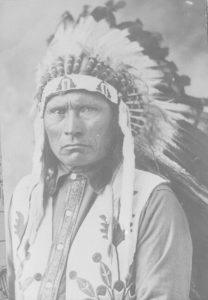Blue Jacket, also known as Weyapiersenwah was the war chief of the Native American Shawnee tribe and was famous for his aggressive defense of the Shawnee Lands in Ohio County. He is a well-known Native American Indian leader of the Northwestern Indian War where pan-tribal sodalities fought many battles with the United States. He was a known predecessor of Tecumseh, a famous Shawnee leader.

The Life of Chief Blue Jacket
He joined the Dunmore’s War and also the American Revolutionary War (they were then linked with the British). He was always fighting to maintain their rights in the Shawnee Land. The British lost against the Americans during the American Revolutionary War causing Shawnee to lose assistance while defending the Ohio County. The battle continued as the white settlers escalated in Ohio, Chief Blue Jacket was the prominent head during the struggle.
On the 3rd of November, 1791, the native Indian tribes’ army headed by Blue Jacket along with Miami Chief Little Turtle defeated Arthur St. Clair who was then leading an American expedition. St. Clair was Northwest Territory’s governor. The encounter was known as St. Clair’s defeat or the Battle of the Wabash. It was the greatest achievement of Chief Blue Jacket’s fighting career and also the most painful defeat that Native Americans ever inflicted on the United States.
But the triumph of he was short-lived. The United States was alarmed by the defeat of St. Clair so they assembled a new army led by Gen. Anthony Wayne. On the 20th of August, 1794, Chief Blue Jacket’s confederate allies fought with Gen. Wayne known as Battle of Fallen Timbers, south of now known as Toledo, Ohio. Blue Jacket’s troops were defeated and on the 3rd of August, 1795, he was forced to sign a treaty known as Treaty of Greenville, surrendering parts of the current Ohio to the U.S.
In 1805, Treaty of Fort Industry was signed by Blue Jacket, giving up more parts of Ohio. In his final years, he saw Tecumseh’s rise to prominence because of his final endeavors in reclaiming Shawnee Lands from Ohio County.
How did blue jacket get his name
In 1877, years after the death of Blue Jacket, a report was published claiming He was actually a white fellow named Marmaduke Van Swearingen. The story said that he was taken and adopted by the Shawnee tribe in the 1770s, about the period of the American Revolutionary War.
Marmaduke van Swearingen family tree
Historians argued that Chief Blue Jacket and Marmaduke Van Swearingen were not the same people. Historical records showed that Blue Jacket was way too older than Van Swearingen and that he was already a well-known chief during the time that Van Swearingen was allegedly captured. Moreover, people who were close to him had no records signifying him as a white fellow. John Sugden, Blue Jacket’s biographer, said that he was certainly a Shawnee since birth.
DNA tests were done among the descendants of Van Swearingen and Blue Jacket to provide verification to the argument. After the initial test using updated techniques and equipment, the DNA result between the two families didn’t match which concluded that he is being a white man was not based on reality.
Weyapiersenwah, blue jacket outdoor drama, blue jacket book, blue jacket hockey, blue jacket bird